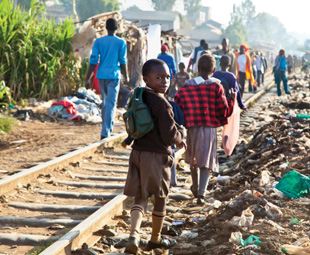From Cape Town to Cairo

Africa is rife with opportunity, but the continent’s development is stifled by its lack of transport infrastructure … all hope is not lost, however, as plans are set in motion to change this narrative.
Boosting tourism and positively impacting ordinary lives in diverse ways – such as aiding the transportation of goods and raw materials and ensuring that people get to the hospital quickly during emergencies – are just some of the advantages of improved road and rail systems on the continent.
Most of Africa’s railway lines and roads are in bad condition and need huge investments, according to the Africa Development Bank (AfDB). The proportion of paved roads on the continent, today, is five times less than those in developed countries, the bank points out.
“As a result, transport costs alone are 63 percent higher in Africa than in developed countries, hampering its competitiveness in the international and local markets,” notes The New Partnership for Africa’s Development (Nepad).
The AfDB further points out that transport costs represent between 30 and 50 percent of total export value in Africa. These costs are even higher in the continent’s 16 landlocked countries and constitute up to three quarters of their total export value.
 “Poor roads and railways also have a negative impact on intra-African trade, which is currently just 11 percent of total trade,” notes Nepad. “Development experts believe this figure might have been higher with better roads and railway lines. Trade among Southeast Asia’s ten countries, at 37 percent, is much higher than in Africa, for example.”
“Poor roads and railways also have a negative impact on intra-African trade, which is currently just 11 percent of total trade,” notes Nepad. “Development experts believe this figure might have been higher with better roads and railway lines. Trade among Southeast Asia’s ten countries, at 37 percent, is much higher than in Africa, for example.”
What needs to be done?
The African Development Bank Transport Forum 2015 – the first of its kind, which was held at the AfDB headquarters in Abidjan, Côte d’Ivoire – ended on November 27, 2015, with the AfDB reiterating its support for transport infrastructure development to ensure economic growth on the continent.
Speaking at the closing ceremony of the two-day event, attended by several African transport ministers, Solomon Asamoah – the Bank’s vice-president for infrastructure, private sector and regional integration – emphasised that Africa’s transport challenges need to be addressed urgently for the continent to become competitive.
He underlined the need for an integrated approach to the development of transport infrastructure systems within countries. This was supported by Angela Cassell-Bush, Liberia’s Minister of Transport, who called for an African master plan to help build a road network connecting Africa.
“We need to review our various regulatory frameworks and come up with one for the whole continent. It will help to facilitate movement of people and boost trade,” she noted.
The damage to Africa’s road infrastructure was attributed to overloading of heavy commercial vehicles. This, coupled with the high maintenance costs, makes the situation worse.
“We spend huge sums of money establishing infrastructure, and run it down without maintaining it,” Asuman Kiyingi, the State Minister of Works in Uganda, pointed out. “In some places some roads do not even last for three years. There is a need for a cultural paradigm shift in how we manage our infrastructure.”
Investing in public transport was cited as key to tackling congestion in cities. Alexis Nzahabwanimana, Rwanda’s Minister of State in charge of transport, said development of public transport would reduce the number of vehicles entering the city, at the same time “increasing the mobility of citizens.” This, he added, would reduce vehicle emissions, which are a health hazard.
A success story
The Abidjan-Lagos Corridor, the flagship project of the Programme for Infrastructure Development in Africa (PIDA), is a stellar example of how Africa can be integrated through infrastructure.
The 1 028-km road, which is under construction, connects Abidjan, Accra, Cotonou, Lagos and Lome. These are considered to be western Africa’s largest and most economically dynamic cities – with a combined population of more than 35-million people.
The six-lane corridor also links vibrant sea ports and serves the whole region’s landlocked countries, facilitating intra- and inter-regional trade. “The corridor is one of the most important developments in the region; it accounts for about 75 percent of trade in the Economic Community of West African States (Ecowas) region”, said Edy Anthony, a transport expert with the Abidjan-Lagos Corridor Organisation.
“When you connect one country with another and one region with another, you reduce transport and trade barriers, and expand business opportunities between countries,” Anthony emphasised. “The corridor is perceived as an instrument for driving the implementation of Ecowas’s flagship protocol on free movement of people and goods.”
 The presidents of the five countries – Cote d’Ivoire, Ghana, Benin, Nigeria and Togo – approved the facility, which is a pilot project under the PIDA Service Delivery Mechanism.
The presidents of the five countries – Cote d’Ivoire, Ghana, Benin, Nigeria and Togo – approved the facility, which is a pilot project under the PIDA Service Delivery Mechanism.
The AfDB is considering a US$ 16 million (nearly R257 million) support package to finance preparatory studies for sections of the corridor.
According to Chris Appiah, a transport and policy expert at Ecowas, the road is the most travelled corridor in western Africa. “It will ensure a more efficient border-crossing system and facilitate regional integration,” he said.
Efforts to establish the corridor were lauded by Silvester Kasuku, the director-general of Kenya’s Lamu Port Southern Sudan-Ethiopia Transport (Lapsset) Corridor Development Authority.
“You cannot go wrong with creating synergy to achieve bigger socio-economic change on the continent,” he noted. When completed, the Lapsset corridor will connect Kenya through Lamu Port to southern Sudan and Ethiopia, making it the gateway to the eastern African sub region and Great Lakes region.
It might be some time before inter-regional cooperation will allow trade to move freely across the whole continent, but plans are being made and the foundations laid … might intra-Africa trade, one day, flow without restraint from Cape Town to Cairo?
Published by
Focus on Transport
focusmagsa




